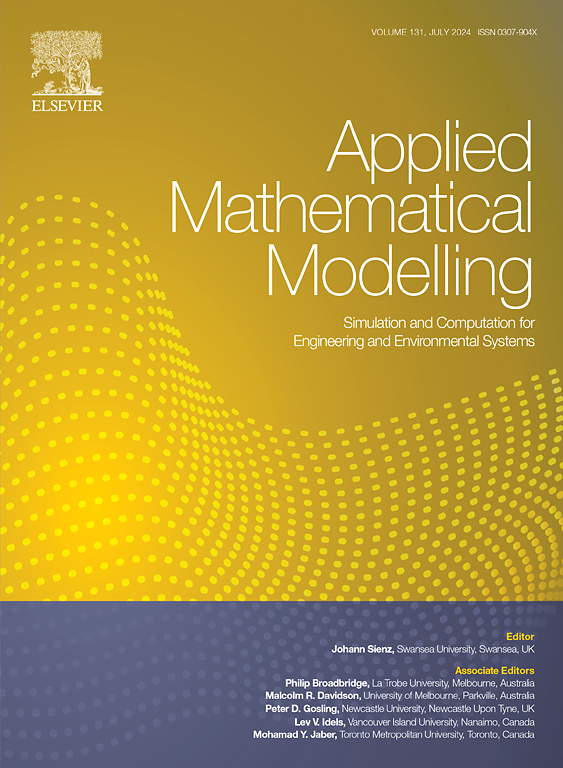模拟电流体动力曲张和鞭打不稳定性的三维数值模型
IF 4.4
2区 工程技术
Q1 ENGINEERING, MULTIDISCIPLINARY
引用次数: 0
摘要
电流体动力锥形射流在微纳米增材制造中有着广泛的应用,其结果多变,是一个被广泛研究的课题。在所有的EHD锥喷流结果中,曲张和抽动不稳定引起了人们的广泛关注,因为它们与不稳定的向下拉伸射流有关。然而,这两种不稳定性背后的机制仍然没有得到充分的理解,部分原因是缺乏一个完整的三维数值模型来模拟这两种不稳定性。在本文中,我们提出了一个三维数值模型,并对电压、液体电导率和液体流速变化下EHD静脉曲张和抽动不稳定性进行了数值研究。利用开源CFD软件OpenFOAM中基于两相有限体积法的流动求解器设计了数值模型。从数值计算结果中,我们得到了临界时刻和关键位置液面和液喷周围的电荷密度和液速分布。这使我们能够分析三个参数的变化对泰勒锥形成的影响,并比较静脉曲张的液体喷射和抽打不稳定性之间的差异。最后,我们将我们的数值结果与最近发表的论文的实验结果进行了比较,对于这两种不稳定性之间转换的标度规律取得了非常好的一致性。据我们所知,这是第一个关于EHD静脉曲张和鞭笞不稳定之间转变的三维数值研究,我们打算从中提供一种新的方法来分析这些有趣但复杂的现象。本文章由计算机程序翻译,如有差异,请以英文原文为准。
A three-dimensional numerical model for the simulation of electrohydrodynamic varicose and whipping instabilities
Electrohydrodynamic (EHD) cone-jet is a widely studied research topic owing to its variable outcomes and broad applications in micro/nanoscopic additive manufacturing. Among all the EHD cone-jet outcomes, the varicose and whipping instabilities attract much attention because of their rich underlying physics involved in the unstable downward stretching jet. However, the mechanisms behind these two instabilities are still not adequately understood, partly due to the lack of a full three-dimensional numerical model for the simulation of these two instabilities. In this paper, we propose a three-dimensional numerical model and perform a numerical study on EHD varicose and whipping instabilities under variations of electric voltage, liquid electrical conductivity, and liquid flow rate. The numerical model is devised with a two-phase finite-volume-method based flow solver in the open-source CFD program OpenFOAM. From the numerical results, we obtain the distributions of electric charge density and liquid velocity at the liquid surface and around the liquid jet at critical instants and locations. This enables us to analyze the differences in Taylor cone formation with the variation of the three parameters and compare the differences between liquid jet emission of the varicose and whipping instabilities. Finally, we compare our numerical results with the experimental findings in recently published papers, with very good agreement achieved regarding the scaling laws for the transition between these two instabilities. To the best of our knowledge, this is the first three-dimensional numerical work on the transition between EHD varicose and whipping instabilities, from which we intend to provide a new approach to analyzing these interesting but complicated phenomena.
求助全文
通过发布文献求助,成功后即可免费获取论文全文。
去求助
来源期刊

Applied Mathematical Modelling
数学-工程:综合
CiteScore
9.80
自引率
8.00%
发文量
508
审稿时长
43 days
期刊介绍:
Applied Mathematical Modelling focuses on research related to the mathematical modelling of engineering and environmental processes, manufacturing, and industrial systems. A significant emerging area of research activity involves multiphysics processes, and contributions in this area are particularly encouraged.
This influential publication covers a wide spectrum of subjects including heat transfer, fluid mechanics, CFD, and transport phenomena; solid mechanics and mechanics of metals; electromagnets and MHD; reliability modelling and system optimization; finite volume, finite element, and boundary element procedures; modelling of inventory, industrial, manufacturing and logistics systems for viable decision making; civil engineering systems and structures; mineral and energy resources; relevant software engineering issues associated with CAD and CAE; and materials and metallurgical engineering.
Applied Mathematical Modelling is primarily interested in papers developing increased insights into real-world problems through novel mathematical modelling, novel applications or a combination of these. Papers employing existing numerical techniques must demonstrate sufficient novelty in the solution of practical problems. Papers on fuzzy logic in decision-making or purely financial mathematics are normally not considered. Research on fractional differential equations, bifurcation, and numerical methods needs to include practical examples. Population dynamics must solve realistic scenarios. Papers in the area of logistics and business modelling should demonstrate meaningful managerial insight. Submissions with no real-world application will not be considered.
 求助内容:
求助内容: 应助结果提醒方式:
应助结果提醒方式:


